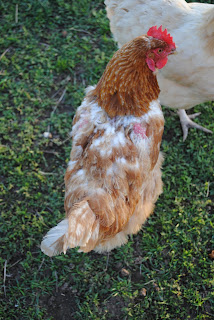One of our pretty Buff Orpington hens, Lola, has a tendency to brood. A couple times of year, she decides she wants to be a mama and sits on the nesting box for weeks at a time. We've discouraged that in the past for a number of reasons - we didn't have a reliable rooster around for any length of time, we didn't really want to mess with baby chicks, and we were afraid of getting more roosters.
So, when Lola went broody, we took all the eggs out from under her and encouraged her to get up and move around. The trouble is that broody hens only have one thing in mind - hatch the eggs to make the babies. Basically you just have to wait until she gives up and gets over the fact that she's not going to be a mother hen.
This spring, we're in our new place in Texas with more land, lots of pasture and a healthy young rooster, Rocky, who (how can I put this) is very active with the ladies. It doesn't take long to catch him in the act. Sorry for the graphic nature of the following photo.
This poor girl below is one of his favorites. You can tell by the lack of feathers on her back and shoulders. I'm thinking about getting her an apron to where so she can heal up.
When Lola went broody again last week, Chet talked me into letting her try and hatch some eggs. I told him he'd have to build her a brooder box so that she can be separated from the others and have a safe place for the chicks to hatch. He went to work!
He made it up as he went along, but I think it's an excellent design. He covered it with chicken wire and we put it on the floor of the coop. I chose 12 eggs for Lola to try and hatch. From my internet research, I found that you should have as many eggs as the bird can safely keep under her and keep warm. The eggs should also be well formed and clean. Since Rocky has been doing his job, I'm hoping most of them will be fertile. (We'll know more when we candle them in about 10 days.)
We waited until dusk and we put the brooder box in the coop. I put the eggs in the new hatching nest.
Lola, of course, was still on the laying nest. We took her out of there and put her in the brooder box on top of the eggs. Everything fit very nicely. Happily, this morning when I went out to check on her and opened the box to give her food and water, she was sitting on all the eggs and didn't even try to get up! I think that's a good sign that she's going to be OK with the move.
Stay tuned for her progress! If all goes well, we'll have baby chicks in 21 days.















